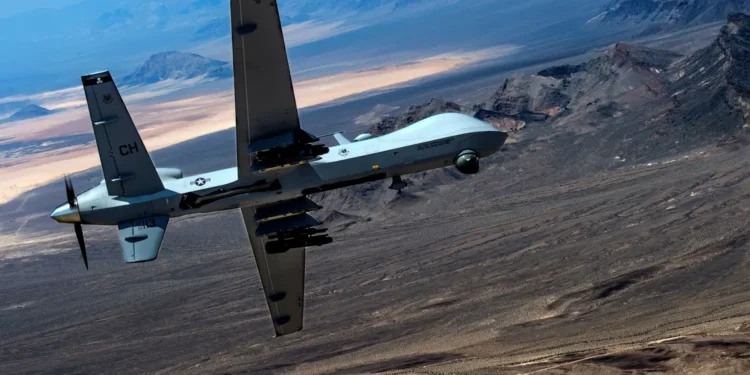Brussels (Brussels Morning Newspaper) – Since the industrial revolution, technological progress has played a major role in shaping the nature of conflict and politics. In the modern era, nations are better equipped to cope with growing challenges because of technological advancements. One of the many marvels of modern technology is the rapid deployment of new and complicated weapons systems with increased lethality and speed, supported by a massive quantum of information. New technologies in the 21st century are affecting national and global safety. One of them is the progress made in drone technology. Let’s talk about whether are drones the future of warfare.
The use of drones in warfare
The United States military first used drone technology during World War One. An airborne torpedo was created and used to attack the enemy. The Queen Bee, a biplane modified for ground-based radio control, was designed in the United Kingdom during the interwar era. Similarly, the United States developed the first operational radio-controlled aircraft, the radio Plane OQT, for use in World War II. Similarly, the United States tested out remote piloting a B-17 bomber during the war.
To spy on the adversary, Israel developed the Tadiran Mastiff UAV and the Israel Aerospace Industries (IAI) Scout drone during the cold war era. General Atomics acquired the prototype GNAT 750 Israeli engineer Abraham Kerim created in 1986. The CIA used it during the Bosnian conflict to destroy Serbian armoured vehicles and ground forces.
Find out Are Drones the Future of Warfare?
Drones like the General Atomics MQ-1 Predator, a modified version of the GNAT-750, were developed quickly during the early 21st century as part of the US military’s response to the global terror threat. This was made possible by combining satellite technology composites and computer miniaturisation. The MQ-1 could fly for extended periods and be piloted from the ground in a different nation. After the 1993 World Trade Center bombing and the 1998 assaults on US embassies in Africa, the first sophisticated drone with surveillance cameras attached was flown over Afghanistan to follow the whereabouts of Al-Qaeda (AQ) leader Osama bin Ladin(OBL). This drone was named Predator.
But after 9/11, the drone represented the US war on terror worldwide. To better strike against terrorists in Pakistan, Afghanistan, and Yemen, the CIA has begun using drones armed with Hellfire missiles. An investigation by the Bureau of Investigative Journalism found that between 2010 and 2020, the CIA launched over 14,000 drone attacks, killing between 8,858 and 16,901.
The US campaign to kill out the top brass of Al Qaeda and ISIS relied heavily on drone operations. The United States now possesses more drones than any other country. According to the Department of Defence, the United States employs more than 11,000 UAS for domestic training and international operations. The RQ-11B Raven is the lightest of these aircraft, a little over 11,000 pounds, while the RQ/MQ-4 Global Hawk/Triton is the heaviest at over 32 tons.
How Do Drones Influence Military Conflict?
Drones have revolutionised defence and counterinsurgency efforts since their introduction to the military-industrial complex. The idea of an autonomous ground or aerial vehicle is not new, but it does provide significant benefits.
Drones have significantly advanced military capabilities around the globe. The following are some of the ways it will further alter military conflict:
1. Improved Capabilities in Reconnaissance, Surveillance, and Target Acquisition (RSTA)
Uncrewed aerial vehicles (UAVs) give ground commanders real-time data on target locations, topography, and adversary activity. Drones have the advantage of being able to go closer to their subjects than high-altitude aeroplanes without negatively impacting the image and video quality.
2. Lowered Expenses
Drones are less expensive overall and need less money to keep flying. Drones eliminate the need for human pilots, decreasing the likelihood of accidents during flight.
3. More Ease
Drones may be deployed quickly and with less effort than traditional planes. Therefore, they don’t need as much training as other planes and are more accessible. Additionally, many drones can take off and land without a runway; some may even be carried in a backpack.
4. Improved Security
Rather than placing themselves in harm’s way, drone pilots may report developments in real time. Moreover, the same data tells commanders where to place their soldiers for maximum protection.
5. Enhancement of Versatility
The military must constantly be prepared for any eventuality. Drones are the finest illustration of how the military-industrial complex has produced technology to meet this need. Drones may be entirely automated, which is a bonus.
Drone technology is now being developed and used by several Military Warfare businesses. Because of the various advantages and benefits they provide, they may serve a wide variety of purposes. Consequently, more and more militaries are considering using drones to enhance their capabilities in warfare and surveillance.
Read More: Polish PM holds crisis meeting after two Russian missiles hit Poland
Conclusion
Are drones the future of warfare? The future wars will be fought without human soldiers thanks to the integration of AI and robotics into every facet of military operations. After the rise of the internet, the next great technological shift will be toward drones and other forms of autonomous systems. As such, it may be a low-hanging fruit for resource-strapped countries like Pakistan to build up their military might. When making long-term investments in defence industries, states must keep the changing nature of warfare in mind.




